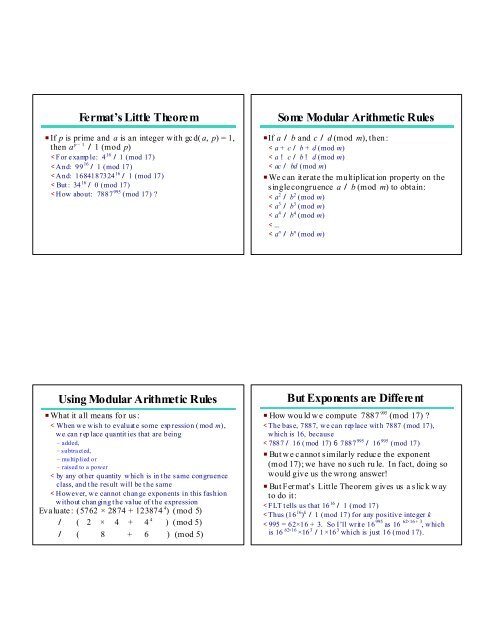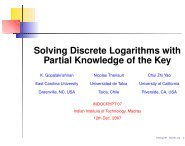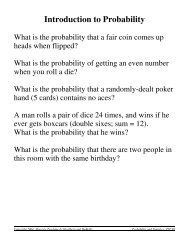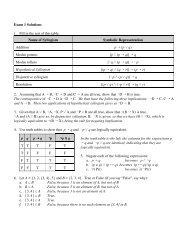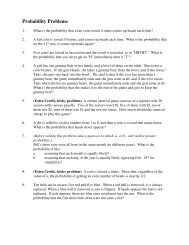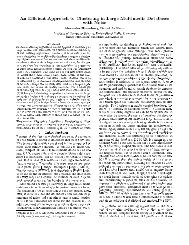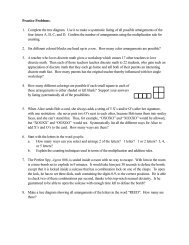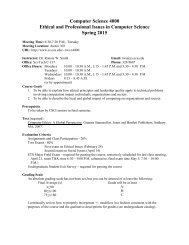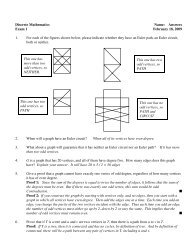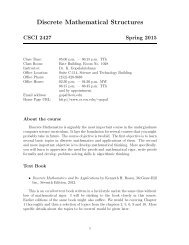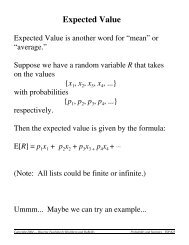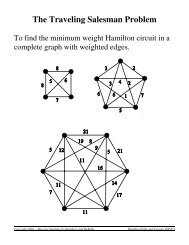Fermat's Little Theore m Some Modular Arithmetic Rules Using ...
Fermat's Little Theore m Some Modular Arithmetic Rules Using ...
Fermat's Little Theore m Some Modular Arithmetic Rules Using ...
Create successful ePaper yourself
Turn your PDF publications into a flip-book with our unique Google optimized e-Paper software.
Fermat’s <strong>Little</strong> <strong>Theore</strong>mP If p is prime and a is an integer with gc d( a, p) = 1,then a p – 1 / 1 (mod p)< For e xamp le: 4 16 / 1 (mod 17)< And: 99 16 / 1 (mod 17)< And: 1684187324 16 / 1 (mod 17)< But : 34 16 / 0 (mod 17)< How about: 7887 995 (mod 17) ?<strong>Some</strong> <strong>Modular</strong> <strong>Arithmetic</strong> <strong>Rules</strong>PIf a / b and c / d (mod m), then :< a + c / b + d (mod m)< a ! c / b ! d (mod m)< ac / bd (mod m)P We c an iter ate the multiplicat ion property on thes ingle congruence a / b (mod m) to obtain:< a 2 / b 2 (mod m)< a 3 / b 3 (mod m)< a 4 / b 4 (mod m)< ...< a n / b n (mod m)<strong>Using</strong> <strong>Modular</strong> <strong>Arithmetic</strong> <strong>Rules</strong>P What it all means for us :< When we wis h to evaluat e some exp ression ( mod m),we can r ep lace quantit ies that are being– added,– subtra ct ed,– multiplied or– raised to a power< by any ot her quantity which is in t he same congruenceclass, and t he res ult will be t he same< However, we cannot chan ge exponents in this fas hionwithout chan ging t he value of t he expressionEva luate : (5762 × 2874 + 123874 4 ) (mod 5)/ ( 2 × 4 + 4 4 ) (mod 5)/ ( 8 + 6 ) (mod 5)But Exponents are DifferentP How wou ld w e compute 7887 995 (mod 17) ?< The bas e, 7887, we can rep lace wit h 7887 (mod 17),which is 16, because< 7887 / 16 ( mod 17) 6 7887 995 / 16 995 (mod 17)P But w e c annot similar ly reduc e the exponent(mod 17); we have no s uch ru le. In fact, doing sowould give us the wrong answer!P But Fer mat’s <strong>Little</strong> <strong>Theore</strong>m gives us a s lic k w ayto do it:< FLT t ells us that 16 16 / 1 (mod 17)< Thus (16 16 ) k / 1 (mod 17) for any positive integer k< 995 = 62×16 + 3. So I’ll writ e 16 995 as 16 62×16 + 3 , w hichis 16 62×16 ×16 3 /1 ×16 3 which is just 16 (mod 17).
Reducing ExponentsPThe ups hot of the prec eeding s lide is that whenreduc ing an expression of the form a b (mod p),where p is a prime number, we reduce the base(mod p) and the exponent (mod p – 1)PSo, to c ompute (as w e did on the pr evious s lide)16 99 5 (mod 17)< divide 995 by 16 t o get a remainder of 3< rep lace t he 995 by 3< and evaluat e 16 3 (mod 17) insteadPSo, if you evaluate 1703 88 42 (mod 7), can you getthe answer by hand? (The answer is 2.)RSA EncryptionP Alice w ishes to be able to rec eive sec uremessages from Everybody< Alice obtains a k ey, K, and a decoder, D< Alice p ublishes her key, K, for Everybody to see< But s he keeps D s ecret< Everybody can use K t o encode the message< Only Alice can decode t he message, using DA Sample Usage of this MethodPPaul w ants to purchas e a book from Amazon.com< He goes t o t he Amazon.com site, selects a book, andthen goes to t he secure "check out " p a ge< A maz on. com sends its p ublic key, K, t o Paul’s browser< Paul ent ers his p ersonal informat ion, and clicks "send"< Paul’s comp ut er encrypts t he informat ion using K, andonly Amazon.com can decrypt itAnother Sample Usage of RSAP Mary wants to download her bank information< She goes to t he bank sit e, which sends her its publickey K< The comp ut er generat es a random key R< The comp ut er encrypts R usin g K, and sends it t o thebank< The bank decrypts t he messa ge t o obt ain R< Now only Mary and t he bank know the key, and t heycan use it t o securely send messa ges back and forth
The Mathematics of RSAP Fe rmat’s <strong>Little</strong> <strong>Theore</strong>m:< For prime and relat ively prime t o , we have a p – 1 / 1( mod p)P The Euler N-function:< For any positive int eger denot es t he number of positiveint egers less than or equal to n which are relativ elyprime to nThe Mathematics of RSAP Eule r’s Ge neralization:< For any a and n, r elatively prime t o each ot her, a N(n) /1(mod n)P Fa cts:< For a prime p, N( p) = p – 1< For primes p and q, N( pq) = ( p – 1)( q – 1)P <strong>Theore</strong>m:< For any a and n, r elatively prime t o each ot her, thereexists a b s uch t hat ab / 1 ( mod n)The Mathematics of RSAP Building the public and private ke ys:< Find two large p rimes p and q, and let n = pq< Select a p ublic key, K , relat ively p ri me t o (p – 1)( q – 1)< Find a privat e D s uch t hat KD / 1 (mod (p – 1)( q – 1))< Select a p ort ion M of t he message wit h fewer thanlo g 2 (n) bits, so that M can be t hough of as a number lessthan n< M is encrypt ed by comput ing M K (mod n)< is decrypted by rais in g it t o the Dth power< It erate until t he whole messa ge is securely sent


